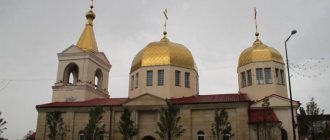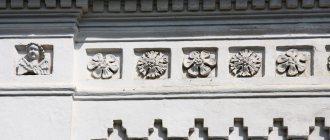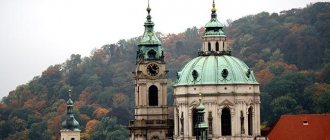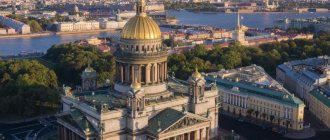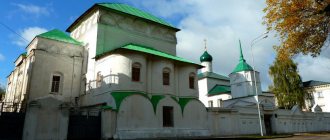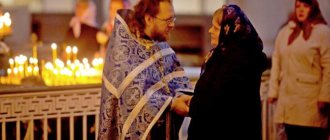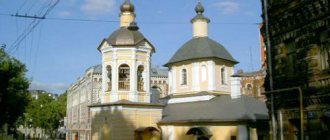Having started the construction of a small rural Temple (temple complex) in 2021, I was faced with the fact that there is practically no information on this topic on the Internet. I decided to describe my experience and mistakes so that it would be a little easier for you who read this blog. The entire construction process is published here: https://vk.com/orehram
During the construction of the Temple, I decided to use modern materials and technologies as much as possible, the main thing is not to the detriment of durability.
Why do some people start building a temple?
The question is rather philosophical.
I have met many people who, for one reason or another, decided to build the Temple. As a rule, ordinary people from the outside say that such people are “atonement for their sins,” “they stole and now pretend to repent,” and so on. Maybe in some cases this is true, but fortunately I have not met such people. I think that if someone truly repents of something and for this reason does something good for people, that is good anyway.
In my case, there were no special reasons or events that prompted me, born in Moscow, to start building a rural Temple 1000 km from the place where I was born. It’s just that at one moment I suddenly realized that I had to immediately begin the construction of the Temple, and for years this became my most important task and meaning of life. Apparently God arranged it this way.
How to open a church
The opening of a temple is a mysterious matter. They don’t teach it at school, they won’t talk about it on TV. It was simple in ancient times: if you built an altar out of stones, here’s a place for you to pray. But now it’s full of all sorts of bureaucracy, and we also need to somehow coordinate with the church. And the building itself must somehow be arranged in a special way, right?
It seems that there is so much information to sift through on how to open a church that it is better not to start. There would be a place where everything is written at once. Yes, here it is! This article has all the main points.
Build a Temple or just donate money for construction?
There is a huge difference between simply donating money for the construction, decoration or repair of a church, or doing the construction yourself. I have donated to church causes and charities for many years. As one wise man, Abbot Alexander, told me, “by sacrificing tithes you will not lose.” This is roughly what I did, donating about 10% of my income to charity. The abbot was right, I didn’t lose weight. During this time, we managed to help in the construction and restoration of several Temples, make a shrine for the relics of St. Martyrious of Zelenetsky in his monastery, restore a cemetery, help a nursing home and simply people who found themselves in difficult life situations. All this time I received only gratitude.
Building the Temple yourself is a completely different matter. Here you need to be prepared for the fact that bumps and adversities will fall on you and your family, as well as cornucopia. The Holy Fathers say that demons really don’t like it when churches appear.
During the construction of the Temple, there were deaths of loved ones, a coronavirus pandemic, an attempted raider takeover of an enterprise, two fabricated criminal cases, a fire at an oil refinery, outrages and humiliation by government services, an assassination attempt and many temptations.
We need to reformat our consciousness
Archpriest Vladimir Shutov, rector of the Church of the Holy Royal Martyrs. Alexandro-Kalinovo:
I believe that the construction of a church is the work of every believer, be it a priest, a deacon or a layman. We are all members of the Church. Christians gather around the parish, so its construction, maintenance, and economic needs are the concern of every parishioner. This is extremely important now, in the era of consumption. Sometimes you hear: “Why should I help the Church?” This attitude leads to the fact that the Church exists on its own, and the believer exists on his own. But we are all inside the Church - this mystical Body of Christ, we are its members, and each of us must do something for it according to our own strength.
It often happens that everything - from cleaning the temple after the liturgy to more global tasks - is entrusted to the priest and several people who try to help him. The correct attitude towards the church needs to be cultivated, we need to talk about it - then we will be able to implement all the tasks assigned to us in the field of missionary work, work with youth, and so on. This will be possible when there are living parishes, consisting of active parishioners who understand that on Sunday they need to stay after the liturgy, discuss and resolve some pressing issues. Some will clean the temple, others will take care of its protection at night, others will think about the issue of heating and draw up a budget. This is a matter for all community members.
duties to the best of your ability. Someone can donate material funds, which will be used to buy coal for the temple. Another does not have this opportunity, but he can chop wood to light the stove in the church before the service. Someone will print a schedule of services, someone will work with children - you just need to think about what you can do for the parish.
This is exactly how I tried to organize everything from the moment I arrived at the parish. I was very lucky that we had people to work with. There was no temple then, but they organized themselves and did everything to open it. There were few active people, but they were there. For fifteen years we have constantly talked about the importance of caring. We have a clear understanding of who is a member of the parish meeting, a member of the parish council, who has the right to vote in the church. Nowadays there is such a problem when unknown people come to the temple and say: “This is my church!” - trying to transfer him to another patriarchy.
We are constantly engaged in educational activities, explaining to people how and what the parish lives. We are trying to convey that the funds do not come from “somewhere”: from the diocese, the metropolis, Brussels or Washington, that the parish is our concern. For twelve years now we have been reformatting the consciousness of parishioners by explaining this. Many people prefer to go to the city, light a candle and leave; they don’t have to worry about the temple. Well, to each his own.
We had such a case when I did not yet live in the village: someone brought flower seedlings and left them at the porch of the temple. I told you to throw it away. It may have been harsh, but sometimes such shock therapy brings results. Those who saw this had to explain: it is good when a priest comes to a temple where there are flowers near the icons. However, leaving the seedlings behind means that the priest must be a gardener: planting, watering, caring for them. The person who left her will then come and say: “Oh, these are my flowers!” - that’s not good. You should not bring flowers, but your desire to help. When a person comes and says: “Father, bless me: I brought flowers, I will plant them near the temple, I will water and care for them, and then we will put them in a vase by the lectern!” - this is the right approach. These are the people who receive the Kingdom of Heaven. But simply throwing seedlings on the porch and considering it a good deed is, I think, wrong. Now I see that people are beginning to understand this, they are trying to organize themselves, decorate the temple for the holiday, and this is very joyful. This applies not only to flowers, of course, but also to all issues related to the life of the temple.
Of course, the priest must also participate in everything that the parish does. If I or my loved ones come to church, then just like the parishioners, we buy candles and prosphora with our own money. If we collect funds for some need, then I, like everyone else, make my contribution. Here it is: if everyone participates, then the priest is no exception.
The story of the Kozelshchanskaya Icon of the Mother of God is very close to me. They wanted to bring a sick girl to the miraculous image, and her mother told her to make a decoration for it. The girl did it and was healed. I still remember the grandmothers who taught: “Baby, are you feeling bad, are you not in the mood? Take a cloth and wash the candlestick - and see how everything changes! Is your child sick? “stay after the service and wash the floors or take some church item home to wash.” People understood that work for the good of the Church was rewarded by God. This understanding, unfortunately, was scorched by the napalm of godlessness during the years of Soviet power, and it has to be restored. Therefore, when people work for the benefit of the temple, gather during off-duty hours, and communicate - this is truly wonderful.
Where to start building the Temple
If the approximate location of construction is already clear, you need to go to the Supreme Bishop of the Diocese (bishop) to which the future (or existing) parish belongs. Only he can give a blessing, thereby allowing the construction of the Temple. The blessing of the bishop is very important since it is he who will subsequently appoint the rector of the Temple. Only the Supreme Bishop has the right to serve the rite of laying the cornerstone and consecrating the Temple (but more on that below).
Before going to Vladyka Philaret (Bishop of Barysh and Inzen), I prepared some sketches of the church by printing out supposed images from the Internet. The first meeting with the bishop turned out to be very memorable. Vladyka did not immediately realize that some person had come from Moscow who wanted to completely build the Temple in a remote rural area of the Ulyanovsk region. I got the impression that he even dissuaded me a little, believing that I did not fully understand what had to be done. The blessing was ultimately received for the construction of the Temple of the Mother of God of her “Life-Giving Spring” icon.
If you want to open a church in a village or city, it is better to start with a small chapel
Start small. A small wooden hut, a chapel, will cost about 100 thousand rubles. It will be built in a short time and without overlaps. If desired, the building can be expanded.
But almost immediately you will be able to organize services and join the life of Orthodoxy. Otherwise, if you decide to build a large cathedral, the work will take a long time. And unforeseen circumstances can completely derail all plans.
The Chapel in the Name of St. Elijah the Prophet in Mokroy Ostrov is an example of a small temple that can be built for the first time. Perhaps later a large temple will be built in its place
Who should own the Temple and land?
I immediately decided that ownership of the acquired land and all the buildings on it, including the Temple, would belong to the Russian Orthodox Church. I know of examples where churches are built on private land, and the building itself is registered as private property. I even know of a case where all the donations from the Temple are taken by the private owner, it turns out to be a kind of business.
In our country there is a special type of organization - a “religious organization”. This is a certain legal form of a community (in my case, Orthodox), which, as a non-profit organization, owns the land, the Temple, and accepts donations. Contracts for energy supply, heating and housing and communal services are drawn up for it. The peculiarity of such an organization is that, according to the law, it does not pay taxes. Such an organization has a Charter, and its leader is the rector of the Temple. An organization may include several Temples (communities).
The activities of a religious organization are regulated by Federal Law 125-FZ dated September 26, 1997. The Diocese must have a standard charter for such an organization. They will also help with registration if necessary.
Allocation of land for the construction of the Temple from local authorities
If local authorities have a plot of land suitable for locating a Temple, the local administration can allocate it free of charge for construction. To do this, the GPZU (urban planning plan for the land plot) must indicate the appropriate purpose - “for public and religious needs.” The purpose of the land plot is very important for further obtaining a building permit.
I went to the district administration with the question of allocating land for construction. I was greeted there like an alien. After I said that I came from Moscow to build a Temple in the village and ask for help with the allocation of land, they definitely considered me crazy. Over time, fortunately, this passed and the local administration helped in every way they could.
In the village where it was planned to build the Temple, there was a historical place where the Temple stood until the 50s of the 20th century, which then burned down. On the site of the old Temple there was a store (general store). The land and the store belonged to a private individual. The owner of the land categorically refused to transfer the land for the Temple. With great difficulty they managed to persuade him to sell the land and the dilapidated store.
Generally speaking, in our country there is a presidential decree of 1996, according to which all church property (including buildings and adjacent land) must be returned to the Russian Orthodox Church. Therefore, in cases where there is at least something left on the site of the old Temple, albeit destroyed, it is much easier to register the property through the court. In my case there was nothing since the old Temple was wooden and burned to the ground.
Decree of the President of the Russian Federation of March 14, 1996 No. 378 “On measures for the rehabilitation of clergy and believers who have become victims of unjustified repression.” Detailed information about church property is here.
The design of the temple should be done by an architectural design workshop
Not so long ago, people could put together a wooden hut and call it a temple. During the Soviet years of persecution, everyone was happy about it. In fact, such construction initiatives still occur today, but less and less often.
An Orthodox church must be built according to strict rules so that it can function. Here you need to take into account both fire safety requirements and the design features of the ventilation system. It is very possible that a project completed by someone new to construction will simply be rejected. But it’s a waste of effort and time.
There are special architectural and design workshops. There are not many of them, but all of them have a state license. Temples based on their designs are easily approved by the architecture and general plan committee, and also undergo the necessary examinations.
But you should make sure in advance that a specific architectural and design studio agrees to take into account the wishes of the customer, and not engage in ad-libs.
Related materials
00:04 — June 29, 2019
Cultural layer
Hundreds of houses across Europe resemble the USSR.
These people see special beauty in them. Finally, the temple has disadvantages from the point of view of economics and urban planning. Many churches are designed to be supported by a parish. In Russia, they register as religious non-profit organizations, are exempt from taxes and have the opportunity to earn money by performing rituals and selling literature. This reduces their dependence on external donations. However, according to Daniil Makarov, it will be difficult to implement this in the church in Pokrovsky-Streshnevo. “It is not yet clear whether the project takes into account the problems of modern church architecture: the possibility of independent maintenance of the church by the parish, the groundwork for the development of parish activities, the application of the principles of sustainable development, energy efficiency, and so on. Perhaps this is not required for a monument temple, whose maintenance will be transferred to the trustees, which puts the project outside the categories of sustainability,” says the architect.
Overall, he calls the temple “quite high quality, but not very distinctive from the rest of the church architecture.” At the same time, according to Makarov, he and his colleagues hoped for an interesting and bright solution, which the authors of the project were unable to offer: “There can be many reasons for this: starting from the peculiar specificity of church architecture, tied to the reproduction of historical forms, and ending interaction of many participants in the design process - in order to create an aesthetically uncompromising project today, many factors must come together.”
The temple project was developed by the architectural bureau SPEECH, founded in 2006 by Sergei Kuznetsov and Sergei Choban and which had never worked on churches before. Among the most notable works of SPEECH are three football stadiums (reconstruction of Moscow Luzhniki, reconstruction of Dynamo and the arena in Krasnodar), the Federation tower as part of Moscow City, many residential complexes in Moscow and St. Petersburg, as well as the design landmark exhibitions, including the Russian pavilion at EXPO 2015 in Milan.
In 2012, one of the two co-founders of SPEECH, Sergei Kuznetsov, was appointed chief architect of Moscow. In his new job, he “supervises large urban development projects implemented in the capital, and also works with the professional community.” Formally, since then he has had no connection with his former bureau and does not have any commercial interests in it - its development is handled by Kuznetsov’s former partner Sergei Choban. However, recently SPEECH has become the most sought-after designer on the Moscow primary real estate market: in 2021, the total area of the projects it implements was 1.93 million square meters (that’s 19 residential complexes). The closest competitor, the Reserve production association, then lagged behind by 2.5 times and received orders for only 760 thousand square meters.
Photo: speech.su
Architectural bureau SPEECH
In addition, SPEECH participated in the design of several objects of national importance. Among them, for example, is the main information pavilion of the sensational Zaryadye Park opposite the Kremlin, the Aquatic Sports Palace in Kazan, built for the 2013 Universiade, residential areas of the Innovation Park (the chairman of the town planning council of which is Kuznetsov), new buildings of the Tretyakov Gallery and the Moscow City Duma. SPEECH received some of these orders even before the appointment of its founder as the chief architect of the capital, and some - after. Moreover, in some (like in the Zaryadye pavilion) Kuznetsov is listed as a co-author of the project.
SPEECH also earned money from Moscow renovation (although it usually specializes in expensive housing), for which Kuznetsov is also responsible. The bureau unexpectedly won the competition for the quarterly renovation of Kuzminki. This area has become one of five experimental sites, the experience of which the capital’s authorities intend to further extend to the entire city. In the fight for votes, the SPEECH jury beat out the world-famous bureau of the founder of deconstructivism, Zaha Hadid. Its experts proposed turning Kuzminki into a new business center of Moscow, building houses with unique architecture - radiating into triangle blocks, and building skyscrapers with cut-off roofs near the metro. However, in the end, preference was given to a rather ordinary project, focused on block development with courtyards and wells.
So that the Temple is convenient, economical and lasts for centuries
The cheaper the construction, the worse the operation. If you save on basic materials, save money for repairs.
Simple country houses have a service life of 40 years, residential individual houses last up to 100 years with one major repair. The main structures of the Temple must last 200 years. During this period, it will be necessary to replace the roof and windows 2 times and repair the facade once.
The following materials and technologies were chosen for the construction of the stone Temple. Foundation - foundation blocks and monolithic base slab. The walls are sand-lime brick, the outside is insulated using the “wet facade” system of Kaparol. The light drum is a metal structure, insulated and covered with flexible aqua panels using the Caparol system. The roof is a metal-wood frame with bitumen shingles. The windows are plastic.
According to our calculations, without repairs (even cosmetic ones), the Temple should stand for about 50 years.
Energy efficiency of the Temple
The biggest expense item for the Temples is electricity and heating.
Despite its relatively small area, the Temple has a significant height, so warming up and maintaining heat in the Temple is a very important task. Even at the stage of construction of the foundation, walls and external decoration, special attention was paid to insulation and heat conservation. To do this, we analyzed all the “bottlenecks” of heat loss, minimized “cold bridges”, and all work related to insulation and sealing was carried out especially carefully.
Please note: WITH YOUR OWN HANDS - how to build yourself a house in a season..
This was completely justified. If there is no gas in the village, heating must be done with electricity. Thanks to good insulation and a smart heating system, the cost of heating with electricity in the coldest months amounted to no more than 6,000 rubles (according to rural electricity tariffs for 2019-2020).
Fire safety of the Temple
Churches are burning. Mainly when they are set on fire. I was shocked when I learned in Russia, in its central part, that burning churches is a common thing. Let’s not forget about open flames of lamps, short circuits and other carelessness. But the main reason was the arson.
That is why it was chosen to build a stone Temple. In the project, we provided everything in such a way that it would be very difficult to set fire to the church. There is not a single exposed piece of wood. All elements of the external facade are strictly non-flammable. Douse it with gasoline and set it on fire so that the fire will simply not spread. We were even able to make the iconostasis virtually non-flammable using modern materials (but more on that below).
This is not the time to sit back
Archpriest Alexander Khvorost, rector of the Church of the Holy Martyr John the Warrior in Druzhkovka:
The construction of churches in the post-Soviet space was a big problem, because during the USSR the authorities destroyed and closed them, reducing the number of parishes. When, after a while, the era of Soviet atheism ended, there were sorely not enough churches for a full spiritual life, and the need arose for their construction. They were erected with great enthusiasm, but priests usually did everything. How did this happen in our region? - the clergy agreed with the heads of enterprises or people who had a desire to participate in construction, they provided all possible assistance.
It is very difficult for a priest to build a temple alone; it is a huge burden. It is necessary to resolve issues of registration of a land plot, documentation, financing, control the purchase of building materials, their delivery, construction work, and so on - not to mention the fact that the priest has his immediate responsibilities: he needs to serve, give communion, baptize, and perform funeral services. But you also have your own family, home, and household. As a result, the priests worked extremely hard during the construction of the temple and paid for it with heart attacks and strokes. Now the trend is changing, since we have built a sufficient number of churches, and communities have gathered around them. Now other problems have arisen - how to maintain these temples when electricity and heating become more expensive, and the buildings wear out and require repairs?
Repairs are the number one problem in most parishes. As they say, there is nothing eternal in the world except repairs. The time has come to rebuild our churches. Now the priests are puzzled by the modernization of temple buildings: it is necessary to carry out thermal sanitation - insulate them, introduce modern technologies in heating and electricity - up to the installation of solar panels, heat pumps, and more efficient heating systems. Specialists are needed in such areas, but the abbot is also obliged to understand them, since this is a matter of the survival of the community. With current gas and heating tariffs, you can’t make ends meet even in a city parish.
The priest needs to involve all parishioners in solving the problems that exist in the parish, and begin by voicing these problems. Yes, not everyone can solve the problem with the roof, but even a child can paint the baseboards, porch or railings - if he has the desire. The clergy must instill the idea: we are all responsible for the temple we go to. I think that we will have to answer before God for how we loved and maintained our churches. Of course, you shouldn’t force people to do something, but you should involve them. Everyone is renovating their houses and apartments, but the temple is also our home, and not even the second, but the first.
Of course, it’s very difficult for people now, especially in Donbass. The region was ruined. Who are our parishioners? - aging women who have almost no health left, or parents who are forced to raise children in the current conditions. We have fewer parishioners than we would like. It's hard for people. Of course, they come to help - for example, our parishioners painted the fence and playground in the summer. In general, few people have the opportunity to help, but we are trying to work in this direction.
Now is not the time to sit back. It often happens like this: the temple stands, but no one goes to it. The area is large, but there is no one to support it. It is impossible to maintain a parish without the feasible participation of believers. Personally, I’m used to relying on my own strengths. During the years of priesthood I learned a lot: I studied the design of autonomous heating systems, installed them, learned how to do electrical wiring, install plastic pipes, install interior doors and windows, not to mention finishing work. With God's help, we implemented all this at the parish, since it was not possible to hire specialists. As our ruling bishop said, if there are no funds, a priest can do a lot with his own hands, and after a while he will see the result of his labors. This is wise advice and I try to stick to it.
It is necessary to build churches, but together. The priest is often left alone with all the problems, and this is wrong. Yes, he must understand everything, he must be taught this in seminary. However, a lot depends on the parishioners. Time presents us with more and more new challenges, and today we must respond to them. A lot of work. The future of the Church is in God’s hands, but we also need to work.
Unsuccessful start of construction
Construction of the Temple (its underground part) began even before the design was completed and a building permit was obtained. The rector of the Temple, Father Valery, performed a prayer service with the temple icon of the Mother of God “Life-Giving Spring”.
To lay the foundation, a contractor from Ulyanovsk, known for building the cathedral in this city, was hired. We agreed with the head of this company to start with the foundation, then proceed to the ground part.
I made a serious mistake in deciding that the contractor’s experience in building the Temple guaranteed anything. Everything happened exactly the opposite. A team and a foreman were sent. A week of drunkenness and desecration of the consecrated construction site. The pit was dug incorrectly, turning it 90 degrees. The contractor was expelled and he never returned the advance. Then I learned that the company was completely bankrupt.
It was decided not to hire a contractor for the entire project, but to involve separate teams for different types and stages of work. This reduced the overall estimate by 40%.
Workers must be hired according to their capabilities: either private traders or from a company
There are no general recommendations about who is better to build a temple. They may be simple enthusiasts, but they are talented. Quite cheaply, private owners are able to build the same thing that a well-known construction company can build at an expensive price. But you can save a lot on different managers, a big name and other extra charges.
On the other hand, private owners have less responsibility. If they do something bad, who can I complain to?
The company is more expensive, but also more reliable. In addition, it is more convenient to order immediately “turnkey” than to look for specialists from different directions at each stage.
Laying the cornerstone
The foundation was completed in record time in less than 2 months. A special niche was left in it for laying stones.
Before the construction of the Temple begins or at its initial stage, a special rite (prayer service) is performed “for the foundation of the Temple,” which has a very ancient tradition. A granite stone (the size of a brick) with a cross carved on it is laid and walled up at the base of the Temple. Spruce (a special aromatic oil) is poured over the stone. A charter (mortgage inscription) is also placed in the niche, indicating when and by whom the Temple was founded.
On the site of the future throne, a wooden cross is installed in the altar. He is present during the entire construction right up to the lighting.
The rite for the founding of the Church of the Most Holy Theotokos “Life-Giving Spring” was performed on October 10, 2021 by the ruling bishop, Bishop Filaret of Barysh and Inzen.
The mortgage deed is placed along with the cornerstone and poured with concrete. The certificate is placed in a sealed capsule. In our case, the capsule is a Chinese thermos, painted gold.
The foundation of the Temple is a great holiday for the community and future parishioners. The arrival of the ruling bishop is also an extraordinary event in the life of a simple village. After the ceremony, a meal is held, a feast for everyone. All this needs to be properly organized.
Sitting at the same table, we started talking with Bishop Philaret. I saw that he was quite surprised that the Temple began to be built so quickly. Having heard about the difficulties with the contractor, who was driven away, he smiled and said that this was only a small part of what else I would have to endure during the construction of the Temple. Then I did not yet know that at that very time a false denunciation was written against me by a person with whom I had worked for 10 years.
Heavenly Jerusalem
An angel measures the walls of the Heavenly City with a golden cane. Drawing by Facundus from the book “Beato de Liébana”. 1047 © Wikimedia Commons
Of the representatives of the Abrahamic religions, only Christians were given the opportunity to know in full detail what the city built in heaven by the Lord himself looks like: an angel appeared to John, one of the closest disciples of Jesus, exiled by the persecutors of the followers of Christ to the island of Patmos to dictate the Revelation ( Apocalypse) is a story about what the end of the world will be like and what should precede it. In particular, at the end of human history, the Heavenly City will descend to earth. It will be a square fortress made of precious stones, the height of the walls being equal to the width. Twelve gates - three on each side of the world - will admit only the righteous. And most importantly, as it was revealed to John the Theologian, there will be no temple at all in that City, for instead of it there will be the Lord himself.
“...And one of the seven angels came to me, who had the seven bowls filled with the seven last plagues, and said to me: Go, I will show you a wife, the bride of the Lamb. And he carried me away in spirit to a great and high mountain, and showed me the great city, holy Jerusalem, which came down from heaven from God. He has the glory of God. It shone like a most precious stone, like a crystalline jasper stone. It has a large and high wall, has twelve gates and twelve Angels on them; On the gates are written the names of the twelve tribes of the children of Israel: on the east there are three gates, on the north there are three gates, on the south there are three gates, on the west there are three gates. The wall of the city has twelve foundations, and on them are the names of the twelve Apostles of the Lamb. He who spoke to me had a golden reed to measure the city and its gates and its walls. The city is located in a quadrangle, and its length is the same as its latitude. And he measured the city with a reed for twelve thousand furlongs; its length and breadth and height are equal. And he measured the wall thereof to be one hundred and forty-four cubits, according to the measure of a man, which is the measure of an angel. Its wall was built of jasper, and the city was pure gold, like pure glass. The foundations of the city wall are decorated with all kinds of precious stones: the first foundation is jasper, the second is sapphire, the third is chalcedon, the fourth is emerald, the fifth is sardonyx, the sixth is carnelian, the seventh is chrysolite, the eighth is virill, the ninth is topaz, the tenth is chrysoprase, the eleventh is hyacinth, and the twelfth is amethyst. And the twelve gates were twelve pearls: each gate was made of one pearl. The city street is pure gold, like transparent glass. But I did not see a temple in it, for the Lord God Almighty is its temple, and the Lamb. And the city has no need of the sun or the moon to illuminate it, for the glory of God has illuminated it, and its lamp is the Lamb. The saved nations will walk in its light, and the kings of the earth will bring their glory and honor into it. Its gates will not be locked during the day; and there will be no night there. And they will bring into it the glory and honor of the nations. And nothing unclean will enter into it, and no one devoted to abomination and lies, but only those who are written in the Lamb’s book of life.” (Rev. 21:9–27)
Heavenly Jerusalem. Tapestry of the Angers Apocalypse. Angers Castle Museum, France. 1373–1382 A series of tapestries of the so-called “Angers Apocalypse” represents scenes from the Revelation of John the Evangelist.
Created for Louis I of Anjou in the workshops of Nicolas Bataille, probably by master Robert Punchon. 74 tapestries have survived to this day and are exhibited in the Angers Castle Museum. © Wikimedia Commons Prepared based on materials from the book by Sergei Kavtaradze, “Seven Books about Architecture,” which is being prepared for publication by the publishing house of the Higher School of Economics. We learn to see and understand.”
Dome of the Orthodox Church
Some issues during the construction of the Temple need to be taken care of in advance. This is primarily the dome and iconostasis, the production of which takes at least 6 months.
Most of the Temples currently under construction have a “golden” dome. Gold on domes is used in special cases as it is very expensive. Now there is an equally beautiful and reliable substitute - titanium nitride. This coating looks no worse than gold, but is much cheaper (about 10 times).
The dome is made of stainless steel plates coated with titanium nitride. The dome frame itself is either metal or made of fiberglass. I chose the fiberglass option because the reliability and tightness of this design is significantly higher, and on-site assembly is quite simple. A fiberglass dome is no more expensive, but more practical than a regular one. Few people know about such domes since only 2 companies in Russia make them. For our Temple, the dome and cross were made in Volgograd.
The diameter of our dome is more than 4 meters. The dome is delivered disassembled into sectors in a regular Euro truck; it can be unloaded manually. Assembled on site in 1 day. The presence of a ready-made fiberglass base guarantees ideal geometry and a precisely ordered shape.
The dome was ordered 9 months before installation. By the time the building was prepared for the installation of the dome, it was already ready at the factory.
First you need to ask yourself: “Is there really a need for a church here?”
The question of the feasibility of construction is not superfluous. Unfortunately, opening a church is often thoughtless. Many representatives of the clergy call for building more churches, arguing that we have one church for every eleven thousand people.
But there are two facts that are kept silent:
It is wrong to build churches on the site of parks and natural areas.
And one more issue that needs to be resolved in advance is to interview people. Perhaps even collect their signatures in support of construction. Alas, it is a common practice when Orthodox churches are built for a reason, but by destroying green parks and other beautiful objects for this purpose.
Construction of the Church of St. Mitrophan of Voronezh in Gatchino
Not every person will be happy about this. And it is right.
In addition, by interviewing local residents, you can find out that, for example, they want to see not a temple in an empty place, but a school, hospital or kindergarten. It is necessary to take into account the wishes of the population. Temples that are built in spite of him only spoil the reputation of the Church. People are starting to see the Russian Orthodox Church not as a spiritual, but as a soulless religious organization.
So construction is a huge responsibility. And you need to approach it wisely.
The iconostasis must be ordered in advance
Making the iconostasis and icons takes at least one and a half years. It is necessary to begin working on the iconostasis as soon as the dimensions of the altar part are clear.
When you look at the iconostasis in a church, it may seem that these are windows from which God and the Saints are looking at you. Or you yourself look at them. How can this be? Very simple. In the iconostasis the Kingdom of Heaven is shown to man. Just like that, through the window.
Work on the iconostasis begins with sketches based on the geometry of the altar. It is determined how many rows the iconostasis will have. The clergy, according to existing canons, determines icons for each niche.
